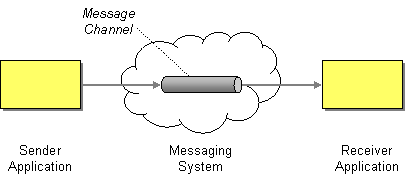4.2. Message Channel
Overview
Copy linkLink copied to clipboard!
A message channel is a logical channel in a messaging system. That is, sending messages to different message channels provides an elementary way of sorting messages into different message types. Message queues and message topics are examples of message channels. You should remember that a logical channel is not the same as a physical channel. There can be several different ways of physically realizing a logical channel.
In Apache Camel, a message channel is represented by an endpoint URI of a message-oriented component as shown in Figure 4.2, “Message Channel Pattern”.
Figure 4.2. Message Channel Pattern
Message-oriented components
Copy linkLink copied to clipboard!
The following message-oriented components in Apache Camel support the notion of a message channel:
ActiveMQ
Copy linkLink copied to clipboard!
In ActiveMQ, message channels are represented by queues or topics. The endpoint URI for a specific queue, QueueName, has the following format:
activemq:QueueName
activemq:QueueName
The endpoint URI for a specific topic, TopicName, has the following format:
activemq:topic:TopicName
activemq:topic:TopicName
For example, to send messages to the queue,
Foo.Bar, use the following endpoint URI:
activemq:Foo.Bar
activemq:Foo.BarJMS
Copy linkLink copied to clipboard!
The Java Messaging Service (JMS) is a generic wrapper layer that is used to access many different kinds of message systems (for example, you can use it to wrap ActiveMQ, MQSeries, Tibco, BEA, Sonic, and others). In JMS, message channels are represented by queues, or topics. The endpoint URI for a specific queue, QueueName, has the following format:
jms:QueueName
jms:QueueName
The endpoint URI for a specific topic, TopicName, has the following format:
jms:topic:TopicName
jms:topic:TopicNameAMQP
Copy linkLink copied to clipboard!
In AMQP, message channels are represented by queues, or topics. The endpoint URI for a specific queue, QueueName, has the following format:
amqp:QueueName
amqp:QueueName
The endpoint URI for a specific topic, TopicName, has the following format:
amqp:topic:TopicName
amqp:topic:TopicName